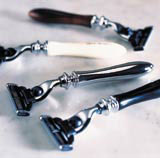Life at the cutting edge
Intelligent innovation drives the men’s shaving market, argues Mike Exon, but a celebrity-driven ad campaign is also a good idea if you want to make the cut

The competitor most affected is probably Schick-Wilkinson Sword, acquired by Energiser Holdings from Pfizer in January of this year. The Wilkinson Sword brand dates back to 1801, when King George III appointed the company to make bayonets for the British army. Now based in St Louis, the US group won acclaim in March with the design of the first four-blade wet razor called Quattro. It has sold well, and pre-empted any move Gillette may have been keeping up its sleeve in the four-blade shaving revolution.
According to last week’s third quarter results from Wilkinson Sword, sales of the group’s shaving products increased by 12 per cent to the end of July 2004, up by $24m (£13m) to $230m (£126m) year-on-year. The company attributes this largely to the success of Quattro, though also notes that the sales were ‘partially offset by anticipated declines in Europe and Asia for other product lines’. Wilkinson also anticipates that its ‘razor share will decline in the September quarter, reflecting sales of recently launched competitor products’. Wilkinson says it grew its share of the blades market from 15 per cent last year to 17 per cent six months ago and up to 18 per cent in the last quarter.
European brands like Germany’s Avid 4 and France’s Bic also hover around the periphery of the market, with their own loyal following. Bic, which derives its name from founder Marcel Bich, was branded by French graphic designer Raymond Savignac in 1962. Savignac designed Bic’s ‘schoolboy’ character. Bic designed its first one-piece razor in 1975 and its Classic Orange product, which is still widely used, four years later. They are manufactured in Greece, France and Brazil.
In its latest annual report, Bic described the retail conditions of the shaver market as ‘challenging’, in part due to the popularity of ‘value-added’ products being sold, such as its recently launched Comfort 3, a triple blade, one piece design launched last March. The female triple blade equivalent, the Soleil, was launched earlier this year, as sales of its single blade designs are on the decrease. Bic sales fell year on year from â„¢287m (£190m) to â„¢257m (£170m).
You might think the bastions of tradition at the upper end of the men’s grooming market – such as Trumper’s and Taylor’s of Bond Street – would turn their noses up at anything other than a cut-throat razor, but not so. Trumper’s accessories business is a substantial contributor to company earnings, says Ben Glazier, managing director of Glazier Publicity & Design, which handles all the barber’s design and marketing activity. ‘As well as cut-throat models we have razors designed exclusively for Trumper’s which fit standard Gillette Mach 3 blades,’ he says.
Interestingly and a little surprisingly, Trumper’s core target market are younger, affluent males in the 20-to-35 age bracket, Glazier explains. Though the company has its regular, older customers, the real purchasing power is with the younger age groups, he says.
Mustachioed innovation gurus like Garry Hamel still talk about finding the next big idea for your business. If you design shavers, it is not enough just to add another blade to your razor and pray, the theory goes. Gillette seems to have taken the hint, but will it be enough to persuade Hamel to shave off his legendary facial hair?
-
Post a comment



